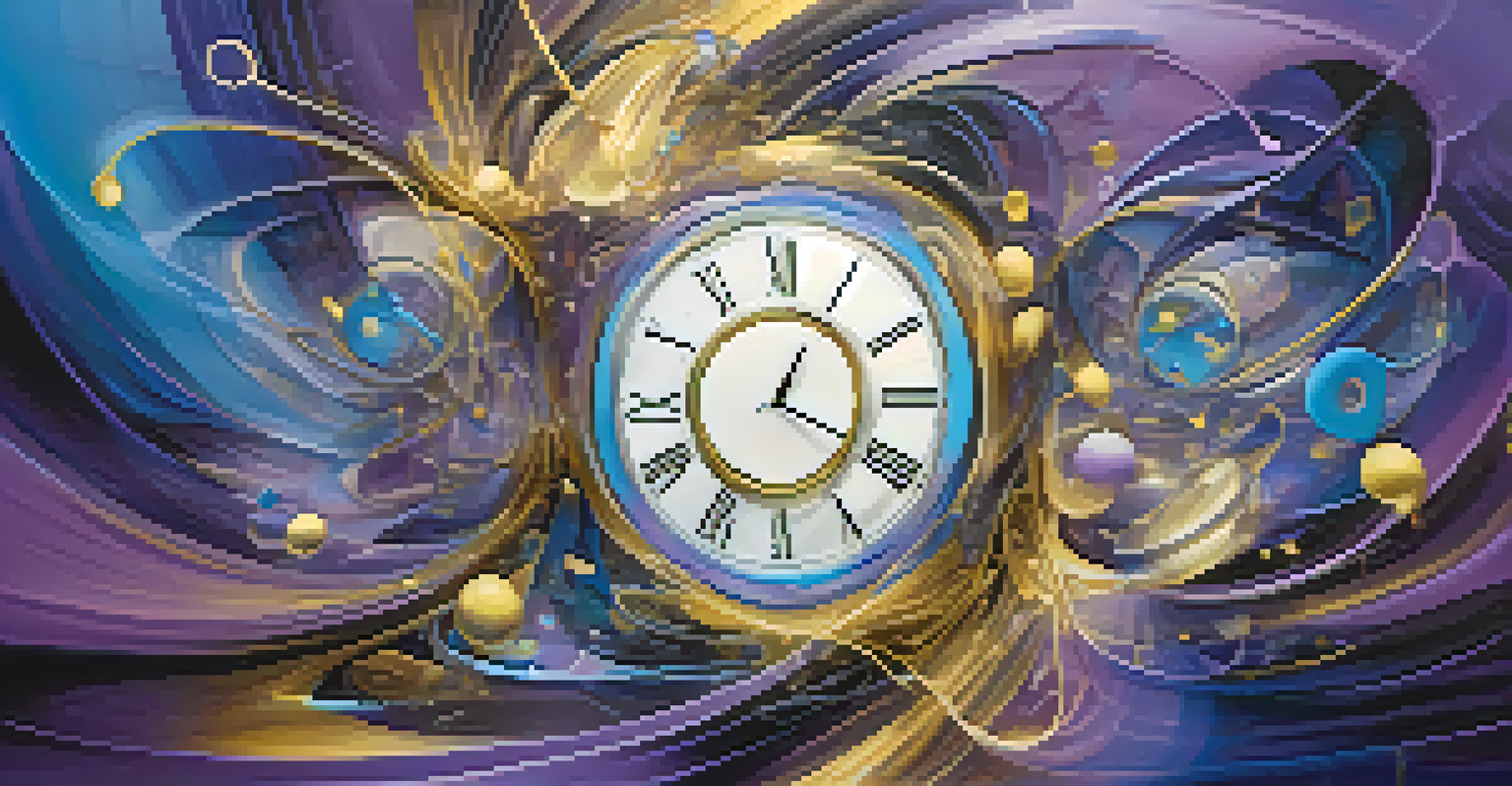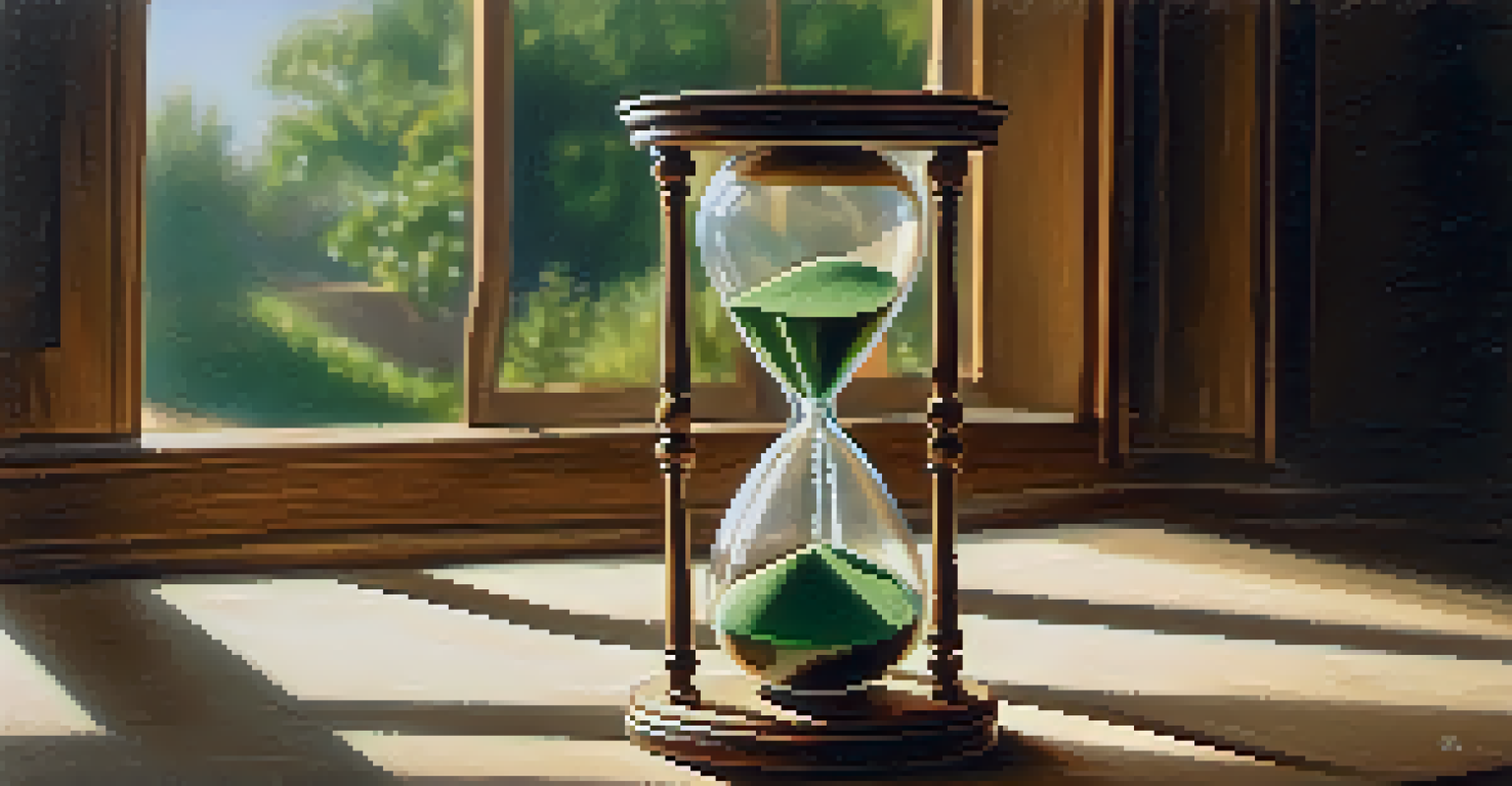Time in Art: How Artists Interpret Temporal Concepts

Understanding Time: A Fundamental Concept in Art
Time is a complex and abstract concept that artists have long sought to represent. While we often think of time as a linear progression, many artists explore its multifaceted nature, expressing moments, memories, and even eternity. For instance, Salvador Dalí's 'The Persistence of Memory' challenges our perception of time, suggesting it is fluid rather than fixed.
Time is a created thing. To say 'I don't have time,' is like saying, 'I don't want to.'
Artists use various techniques to depict time, whether through movement, change, or the passage of seasons. They may capture fleeting moments, like a sunset, or depict the cycle of life, as seen in Van Gogh’s 'Starry Night,' which illustrates a dynamic night sky. This duality in representation allows viewers to contemplate their own experiences with time.
Ultimately, understanding how artists interpret time can deepen our appreciation for their work. By recognizing the different ways time can be portrayed, we become more aware of the emotional and philosophical layers that art can convey.
Temporal Perspectives: Different Cultures and Time
Time isn't universally understood; it varies greatly across cultures. Indigenous cultures, for example, often view time as cyclical, tied to nature and traditions, while Western cultures tend to see it as linear, focused on progress and future outcomes. This distinction affects how artists from different backgrounds express temporal concepts in their work.

Take, for instance, the art of Japanese ink painting, which often embodies a sense of tranquility and connection to nature's rhythms. These works invite viewers to reflect on the passage of time in a more meditative manner, contrasting with the urgency often found in contemporary Western art. Such differences remind us that our cultural lens shapes our interpretation of time.
Art Reflects Cultural Time Views
Different cultures perceive time uniquely, influencing how artists represent temporal concepts in their work.
By exploring various cultural perspectives on time, we can uncover rich narratives within art. These narratives not only enhance our understanding of individual pieces but also foster a greater appreciation for the diversity of human experience.
The Role of Technology: Time in Digital Art
As technology evolves, so too does the way artists interpret time. Digital art allows for unique representations of temporal concepts, enabling artists to play with motion, animation, and virtual reality. For example, artists can create immersive installations that change in real-time, engaging viewers in a dynamic exploration of time.
The only reason for time is so that everything doesn't happen at once.
Digital platforms also provide tools for artists to manipulate time, such as creating loops or time-lapse videos. These formats challenge traditional notions of time, inviting audiences to engage with art in ways that are often impossible in physical spaces. This shift opens up new avenues for storytelling and emotional resonance.
The intersection of technology and art highlights the ongoing evolution of temporal interpretation. As artists continue to experiment with digital mediums, our understanding of time in art will likely expand, reflecting the complexities of modern life.
Art Movements and Their Temporal Themes
Throughout history, various art movements have grappled with the concept of time, often reflecting societal changes and technological advancements. For instance, Impressionism emerged in the late 19th century, capturing fleeting moments and the effects of light in a way that emphasized the transient nature of reality. This movement marked a significant departure from the more static representations of earlier periods.
Similarly, Futurism embraced the idea of speed and movement, celebrating modernity and the dynamism of the industrial age. Artists like Umberto Boccioni sought to convey the energy of their time, representing time as a force that propels society forward. This thematic focus on time reveals how art can mirror cultural shifts.
Technology Transforms Time in Art
Digital art allows for innovative interpretations of time, enabling immersive experiences that challenge traditional representations.
By examining these movements, we gain insights into how artists respond to their contemporary contexts. The exploration of time in art is not just a reflection of individual creativity but also a commentary on the world around us.
Memory and Time: An Artistic Exploration
Memory plays a crucial role in how we perceive time, and many artists delve into this relationship through their work. The act of remembering can distort our sense of time, making the past feel vivid and present. Artists like Christian Boltanski explore memory's impact on identity, often using found objects and photographs to evoke nostalgia and reflection.
This exploration of memory also invites viewers to engage with their own experiences. When we encounter art that triggers memories, we find ourselves contemplating our personal timelines, connecting to the universal human experience of remembering. Such artistic expressions can be both comforting and challenging.
By highlighting the interplay between memory and time, artists encourage us to consider how our past shapes our present. This connection adds depth to our understanding of temporal concepts, illustrating that time is not just a measurement but also a deeply personal journey.
The Fluidity of Time: Art and Perception
One of the intriguing aspects of time in art is its fluidity—how our perception of time can change based on context and presentation. Artists often manipulate elements like color, form, and composition to create a sense of movement or stasis, altering our experience of time. For instance, the use of blurring in a painting can evoke a sense of speed, while stillness can invite contemplation.
This manipulation of perception extends beyond visual art; it is also evident in literature and performance. Writers may play with narrative structure, presenting events out of chronological order to reflect the complexities of human thought and memory. Similarly, theater and dance can explore time through choreography, illustrating how bodies move through space and time.
Memory Shapes Our Perception of Time
Artists explore the relationship between memory and time, inviting viewers to reflect on their personal experiences and the passage of time.
By engaging with the fluidity of time, artists challenge us to rethink our own perceptions. Their works encourage us to question how we experience time in our lives, ultimately leading to a more profound understanding of the world around us.
Time as a Philosophical Concept in Art
Art also serves as a medium for philosophical contemplation about the nature of time. Many artists grapple with existential questions related to time, such as impermanence and the human condition. For example, the works of Andy Warhol explore the fleeting nature of fame and consumer culture, inviting viewers to reflect on the passage of time in a rapidly changing world.
This philosophical exploration often manifests in artwork that provokes thought and dialogue. By confronting viewers with the realities of time—whether through decay, transformation, or the ephemeral nature of beauty—artists create spaces for introspection and discussion. Art becomes a mirror reflecting our own temporal experiences.

Ultimately, the intersection of art and philosophy enriches our understanding of time. By engaging with these ideas, we can uncover deeper meanings in artistic expressions and appreciate the ways in which they resonate with our lives.